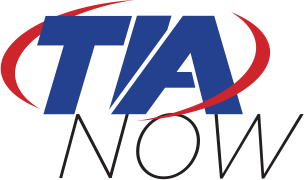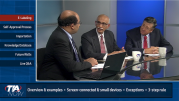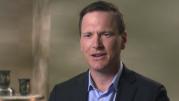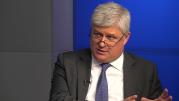TIA
Featured Video
-
What will define 5G is coming into focus. The need for an effective standards process, that will represent the varied stakeholders, is critical. TIA NOW discusses this process and shows a working demo of 3 future capabilities of 5G.
All TIA Videos:
-
Accelerating the development and adoption of NFV requires working with service providers and ecosystem partners to help build deployable solutions. But what barriers still exist that prevent virtualized networks from being deployed everywhere today? Timon Sloane, VP of Standards and Membership at the Open Networking Foundation, shared his advice on navigating the complexity of NFV adoption and how industry can benefit from open source platforms.
-
On July 13, the FCC updated its Equipment Authorization rules to provide flexibility to manufacturers to use electronic labeling in lieu of a physical label or nameplate, and took steps to streamline the certification process for telecommunications equipment and devices imported into the United States. Julius Knapp, Chief of the FCC’s Office of Engineering Technology and Rashmi Doshi, Chief of the FCC’s Office of Engineering Technology Laboratory Division, dive into the agency's new e-labeling and device certification rules, and explain how it will benefit regulators, manufacturers, and consumers alike.
-
The big data and data science revolution is upon us as firms are currently spending an estimated $36 billion on storage and infrastructure, that will double the data mining sector by 2020. Here with us in the TIA NOW studio to talk about predictive analytics is Richard Boire, SVP of Environics Analytics.
-
Two experts talk with TIA about how to negotiate a deal that will expand U.S. tech jobs. TIA’s K.C. Swanson speaks with Brownstein Hyatt’s Barry Jackson, former chief of staff to former House Speaker John Boehner, and Jen Sanford, Director of International Trade and Energy Policy at Cisco. They offer up thoughts on the outlook for modernizing NAFTA on a short timeline, what’s needed for an update, and why improving the deal matters for high-wage American jobs.
-
If you haven’t heard about millimeter-wave technology, you weren’t listening. High frequency bands that allow for multi-use applications in public safety are already in the test phase. Aditya Dhananjay, Post-Doctoral Fellow at NYU's research center, NYU WIRELESS, spoke with Abe Nejad about why millimeter-wave technology for public safety communications is less understood and what unique challenges it presents.
-
5G antenna design will be vastly different as we transition from 4G to 5G. From the interface between the antenna and the radio frequency front end, the use of arrays instead of single antennas and the use of beam steering, just how different will it be? Here to tell us is James Kimery, Director of Product Marketing for RF Communications and Software-Defined Radio at National Instruments.
-
Analysts from IDC including spoke with TIA NOW about the tough issues that the communications technology industry is currently tackling, which were covered at the TIA Connectivity Jam in Dallas, TX. These issues span from data management, edge computing, connected devices, network benchmarking and artificial intelligence.
-
Carl Rivkin, Manager of Safety Codes and Standards at the National Renewable Energy Laboratory (NREL), spoke with TIA NOW about how fuel cells act as reliable back-up power for cell towers. Rivkin focused on the environmental, safety and connectivity benefits of fuel cell technologies.
-
Gary Bolton, VP of Global Marketing at ADTRAN, spoke with TIA NOW about how the value of networks is based on the number of users of a platform. Bolton goes on to say that being able to match producers with consumers is the key to a successful platform economy.
-
Robert Conger, VP of Cloud and Portfolio Strategy at ADTRAN, spoke with TIA NOW about how CSPs and web-scale players are now on equal playing fields through SDN technologies, by deploying more open and programmable networks. Conger continues to say that operators are successful in employing software and open source principles in their central offices.
-
Christopher Millward, head of the U.S. Information Technology Office (USITO), a policy research group in Beijing, explains how China’s protectionist policies hurt U.S. exporters.
-
Scott Armul, VP and GM at DC Power and Outside Plant Products at Vertiv, spoke with TIA NOW about the balance of using legacy networks and new infrastructures. Armul goes on to say that the trend of compute power being pushed to the edge of the network allows Vertiv to reduce latency and improve the experience for the end user.
-
Trevor Smith, VP of Strategy and Business Development at CommScope, spoke with TIA NOW about the importance of optimizing the upload of video, as users create more content at the edge. Smith talks further about how CommScope is preparing for 5G networks, including densification and optimization of the network.
-
Vernon Yow of Sumitomo Electric Lightwave talks about ribbon technology and how that impacts improved cabling. Yow speaks further about the applications of ribbon technology for data centers and how ultra-high-fiber-count ribbon cables meet the growing need for high fiber density in data centers.
-
Kevin Koppenhaver, Senior Program Director at Belcan, spoke from the TIA Connectivity Jam in Dallas, TX about cybersecurity in avionics and automotive. Koppenhaver stressed the issue of vulnerabilities that are created when adding nodes to devices, and whether industry is reviewing the process of adding network nodes.















